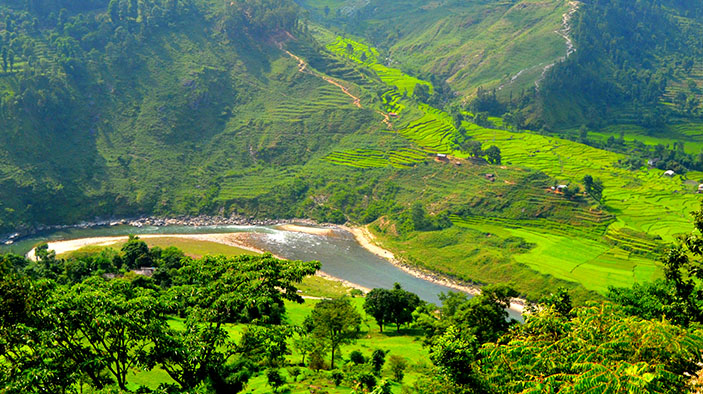Nepal—Paani
Client: U.S. Agency for International Development
Duration: 2016-2021
Region: Asia and the Pacific
Country: Nepal
Solutions: Environment Climate
The water that courses through Nepal’s great Karnali, Mahakali, and Rapti river basins irrigates the region’s farmland and sustains the health of its people, while also providing a critical habitat for diverse freshwater species and propelling the hydroelectric dams that help to power the country. However, important water resources such as these are increasingly strained by population growth, changes in climate, and indiscriminate use—stressors that will become more severe if left unchecked.
The Paani (meaning “water” in Nepali) program, funded by the U.S. Agency for International Development, played a pivotal role in protecting these critical water resources by working with local and national counterparts to conserve freshwater biodiversity and implement sustainable water management practices.
Paani raised the profile of freshwater issues through policy engagement, academic research, curriculum development, and sponsorship of international forums. The project emphasized user-centered design to analyze how various stakeholders, including fishermen, government officials, and hydropower developers, use water resources to better incentivize their engagement in water conservation and management activities.

Sample Activities
- Train diverse groups (engineers, teachers, planners, village groups, and government staff) in the importance of and methods for freshwater conservation and protection of local ecosystems.
- Create multi-stakeholder platforms to share lessons, plans, and news through roundtable discussions and information communication and technology tools such as websites, social media, listservs, and text messages.
- Create a Freshwater Center of Excellence to serve as a repository for technical tools, training, and scientific assessments and transition knowledge to local institutions for sustainability.
- Collaborate with engineering and construction firms and government ministries to develop a best practices guide for green infrastructure construction.
- Develop and implement a university-level green engineering curriculum and provide scholarships, internships, and/or mentorships for Nepali students pursuing related fields.
Select Results
- Developed an Aquatic Animals and Biodiversity Conservation Bill, which was endorsed by three municipalities.
- Launched an Integrated Water Resources Management course and scholarship program at Mid-Western University. The scholarship program expanded the reach of the program to humanities and social science students, as well as those from marginalized backgrounds.
- Completed, by engaging hundreds of citizen scientists, comprehensive watershed profiles, and watershed health reports for eight priority watersheds. These reports, and the consultative process used to create them, narrowed the knowledge gap and created a shared understanding of ecosystem health.
- Facilitated the development of a Flood Early Warning System, which in July 2020 sent text alerts to 38 key contacts when the water level crossed the “warning level” in the river in the Lower Karnali Watershed. These contacts then passed the messages on, reaching more than 5,500 people in 1,000 households. With the FEWS securely in place, more lives and properties are spared during floods.
- Through community engagement, social inclusion, open communication, and support for local legislation, Paani established more than 100 community groups to co-manage over 450 kilometers of river with local governments, supported the enactment of the National Water Resources Policy, created the first river basin conservation financing mechanism in Nepal, and established a national freshwater data-sharing platform.
Featured Links
RELATED CONTENT:
Liberia—Long-Term Technical Assistance for the Implementation of the Voluntary Partnership Agreement (FLEGT-VPA)
This project increases the value of traded timber products, strengthen forest law enforcement and governance, and share forest benefits more equitably through implementation of the Forest Law Enforcement, Governance, and Trade Voluntary Partnership Agreement between Liberia and the European Union.
Read More